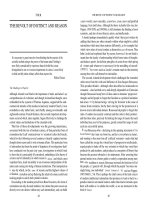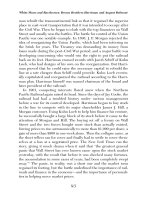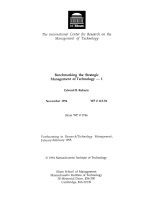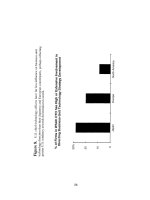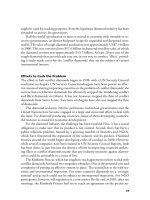The Jack Welch Lexicon of Leadership phần 4 ppt
Bạn đang xem bản rút gọn của tài liệu. Xem và tải ngay bản đầy đủ của tài liệu tại đây (212.88 KB, 21 trang )
managers who are responsible for defining Six Sigma projects.
Their responsibilities include setting and maintaining broad
goals for Six Sigma projects, coaching, obtaining resources,
smoothing out problems, and applying Process Improvement
to their own management responsibilities.
Change: What companies must embrace to move ahead. By
harnessing the power of change (rather than fighting or
fearing it), companies can achieve a competitive advantage.
Welch has said that people will always want to know when
the change is over, when they can “stop changing” and just
get on with things. Welch’s response was unequivocal: “No,
it’s just begun.” That Welch response is an apt summary of
the Welch years, in which change was a constant. One of the
keys to GE’s values is that it includes a statement on change.
At GE, employees are urged to think of change as an oppor-
tunity and not a threat. In his last year at the helm, Welch
explained that “predicting is not what it’s all about. It’s
about responding to change, it’s moving with change. It’s
being adaptive. It’s not about the precision.” Welch also said
52 THE JACK WELCH LEXICON OF LEADERSHIP
that change is in the genes of every GE employee: “We
breathe in our blood every day, now is the time to change
the game.”
THE SIGNIFICANCE OF WELCH AND CHANGE
One of Welch’s great contributions is the way he approached
the topic of change. From his first days in the CEO’s office, he
recognized that change was not only inevitable, but also
sorely needed. Once again, we see how Welch was the right
leader at the right time. In the late 1970s and early 1980s,
most business leaders had little appetite for change. Even a
weak economy and the threat of new global competitors were
not enough to shake up most CEOs. Welch not only recog-
nized the need for change, he saw the need for radical change,
and then set out to turn the company and its century-old tra-
ditions upside down.
Change lessons
1. Change is a constant, and people in the organization must face
it: Legendary coach Vince Lombardi said that “winning is not
a sometime thing.” Welch felt the same way about change. He
urged his managers not only to live with change, but also to
exploit the opportunities that come with change. For example,
Welch knew that manufacturing alone would not deliver the
growth he sought. As a result, he embarked on an ambitious
plan to make service the centerpiece of GE’s growth engine.
In 2000, service accounted for more than 70 percent of GE’s
revenues.
2. Never stop communicating on the topic of change: Since
change is a constant, managers and employees must learn not
only to live with it, but also to embrace it. Change can help
organizations, but only if people are prepared. In the 1980s,
Welch preached on change at Crotonville and used other parts
of the operating system to drive change throughout the com-
THE JACK WELCH LEXICON OF LEADERSHIP 53
pany. In his final year as chairman, Welch said that change is “in
the company’s blood.”
3. Stay one step ahead of change: One of the factors that fueled
Welch’s success was his prescience. Welch not only faced real-
ity, he saw it coming long before his competitors. Stay one
step ahead of change by monitoring the competitive environ-
ment (e.g., competitors’ websites, global economic condi-
tions), staying in touch with people from all corners of the
organization, and encouraging communication up and down
the hierarchy.
Change Acceleration Program (CAP): This was
the third phase of Work-Out. In the early 1990s, after Welch
implemented his Work-Out program, the GE CEO decided it
was time for the company to field its own team of change
agents. He recognized that he could not do it alone; he needed
facilitators. It was not enough that managers simply ran
departments, they also had to spearhead Welch’s change ini-
tiatives. Starting with senior managers, GE trained executives
to be effective advocates of the change he felt was necessary to
make GE a lean and agile enterprise. The goal of CAP was to
provide managers with the tools and training they need to
engineer and drive change throughout the company.
Clausewitz, Karl von (1780-1831): In honing his
own strategic thinking, Welch drew on the strategies of the
Prussian general and military writer. Clausewitz’s writings,
including his classic On War, were edited and published by his
widow after the general’s death. His work and writings, such
as his “no system of strategy,” formed the basis for all serious
study of war. Welch quoted the general, whose theories
included an explanation of why a military leader could not
devise a complete battle plan and then stick blindly to it:
“Man could not reduce strategy to a formula. Detailed plan-
54 THE JACK WELCH LEXICON OF LEADERSHIP
ning necessarily failed, due to the inevitable frictions encoun-
tered.” And: “Strategy was not a lengthy action plan. It was the
evolution of a central idea through continually changing cir-
cumstances.” Welch’s own strategic thinking matched the gen-
eral’s. He constantly reinvented GE over the years as circum-
stances and the competitive environment shifted.
HOW WELCH APPLIED CLAUSEWITZ TO GE
While Welch did maintain a long-term view at GE (e.g., creat-
ing strong businesses that would survive in the long run), his
approach to his strategies and initiatives followed Clausewitz’s
doctrine. There was an evolution to Welch’s strategic think-
ing, and each major initiative built on the one that preceded
it. By waging “war” on bureaucracy and the old ways one
movement at a time, Welch established a solid foundation on
which he eventually built GE’s famed learning organization.
He would wage one “battle” and then wait to see how the
“inevitable frictions” played out. In tracing the evolution of
GE during his tenure, Welch has drawn a stair-step-like chart
that depicts the stages of GE’s culture change: Work-Out laid
the foundation for Best Practices, which created a platform
for Process Improvement, etc.
Leadership lessons from Clausewitz
1. Strategy cannot be reduced to a single formula: Clausewitz
knew that no single formula would help to win a war.
Circumstances would shift, requiring a general to alter his strat-
egy after the battle ensued. The same holds true for business, as
shifting conditions require business leaders to alter their strate-
gies in the face of changing conditions (economic, competitive,
technological, etc.).
2. Do not write a long-term plan and blindly follow it:
Clausewitz knew it was foolish to blindly follow a plan that was
written before a battle took place. “Strategy was not a lengthy
THE JACK WELCH LEXICON OF LEADERSHIP 55
action plan.” Welch knew he would have to be an adaptive
leader, tailoring the strategy to the latest conditions.
3. Do not think that simply applying all Welch strategies will
work in your organization: This is a key Clausewitz lesson.
While few would dispute Welch’s contributions, one cannot
blindly imitate his every move. Welch launched his companywide
movements one initiative at a time. His success was built on “the
evolution of a central idea through continually changing circum-
stances.” Your “business laboratory” is not identical to GE’s, and
the “inevitable frictions” in your organization will differ accord-
ing to the changing circumstances. It took Welch many years to
transform GE’s culture and ready the company for his company-
wide initiatives.
Competitiveness: Creating the world’s most competitive
enterprise was Welch’s mantra from the beginning. He felt that
the company had “infinite capacity” to achieve and make
things better. As late as the mid-1990s, Welch had proclaimed
that GE “has barely scratched the surface.” Welch said that
competitiveness was about “tapping an ocean of creativity.”
That notion formed the nucleus of his key strategies and ini-
tiatives. Everything from Work-Out to Six Sigma to e-Business
was designed to unleash the competitive spirit and boundless
abilities of all GE employees and managers. The GE operating
system was the primary vehicle used to drive actionable learn-
ing that would boost productivity and competitiveness.
A Competitor: Where one should look to glean new ideas.
In Welch’s learning organization, he urged all GE employees
to soak up ideas from competitors (and anywhere else good
ideas originated). Welch was the first GE CEO who admitted
that he did not have all the answers and declared learning
from others a “badge of honor.” In 1989, GE launched Work-
Out, a program that at its core holds that management does
56 THE JACK WELCH LEXICON OF LEADERSHIP
not have all of the answers. Later, in building a learning cul-
ture, Welch urged workers to soak up good ideas and Best
Practices from other companies. In creating GE’s social archi-
tecture, Welch was saying that it is not only acceptable to
learn from others, it’s your job. Welch credits other compa-
nies, such as Chrysler, IBM, and Motorola, with helping GE
learn about everything from product introduction to global-
ization to Six Sigma.
Complacency: What Jack Welch had to fight from the
minute he assumed the top job at GE. For years GE was
regarded as a model corporation, envied the world over for its
management, products, and organization. Welch knew better,
recognizing the need for massive change. He was not afraid to
shake the company to its core in order to fight complacency
and reinvent the century-old institution as a global competi-
tor. Many of Welch’s strategies and initiatives were designed
to battle complacency. Six Sigma, for example, was launched
in 1995 after Welch learned that employees felt that the qual-
ity of GE’s products had slipped. GE’s Six Sigma program
entailed the never-ending pursuit of improvement in every-
thing from its products to its financial service transactions.
σσσσσσ
Confidence: “Instilling confidence” and “spreading it” around
the organization was the most important thing he did, Welch
insisted. After making so many dramatic changes in his hard-
ware phase of the 1980s (layoffs, restructuring, divesting), Welch
knew that he had a demoralized workforce. Through initiatives
like Work-Out, he sought to instill confidence into the psyche of
GE employees and managers. Confidence has been a constant
theme throughout Welch’s tenure, and many of his initiatives
had the added benefit of instilling self-confidence into the
organization. Six Sigma, for example, gave GE employees far
more confidence in the quality of their products and services.
THE JACK WELCH LEXICON OF LEADERSHIP 57
The e-Initiative added speed and confidence to the organiza-
tion, as workers became more secure in the knowledge that an
upstart dot-com would not steal sales or market share from GE.
Declared Welch: “A manager’s job is to fundamentally pump
self-confidence into people so they have the courage to dare, the
courage to dream, the courage to reach and do things they never
thought possible.”
THE ORIGINS OF WELCH’S CONFIDENCE
Welch says that he started to build self-confidence at an early
age and often gives credit to his mother for being so well
grounded. His mother certainly instilled a sense of reality into
her son, Jack. Months before his retirement, Welch spoke of
how she taught him early on to see things as they are: “Never see
the world the way you wished it would be. Always see the world
as it is.” In other words: “Don’t kid yourself.” It was a common
retort from Jack’s mother, and his first lesson in facing reality.
Welch also regales interviewers with his boyhood tales of the
“Pit.” That was where he played sports and learned lessons
that would prepare him for the world of business. One jour-
nalist called the Pit a “Darwinian laboratory of sorts,” since
that was where “Welch and his buddies learned to win, lose,
fight, compromise, and charm.” Welch has often decreed
“sports are everything” and attributes his early years to shap-
ing his leadership abilities.
Another factor Welch pointed to in building confidence was
his attending a state school rather than a more rigorous insti-
tution like MIT: “I’m a firm believer that all of these experi-
ences build these self-confidences in you: your mother’s knee,
playing sports, going to school, getting grades.” After graduat-
ing from the University of Massachusetts, he received his
master’s and Ph.D. before starting at GE. He was in a small lab
with only one other person, and he thought it more like “a
58 THE JACK WELCH LEXICON OF LEADERSHIP
family grocery store.” There was no bureaucracy, just excite-
ment, as Welch built the business.
Later, at age 33, he would become an executive responsible for
a $1.5 billion components and materials group. Once he
moved up the GE ladder, he was exposed to all of the things
he would fight later on, including bureaucracy, layers of man-
agement, turf battles, etc. By working in such a small opera-
tion in his earliest days at GE, Welch knew that it was possible
to work for a vast corporation and still have it run like a small
store. Throughout his career, Welch felt that “pumping self-
confidence into people” is one of the fundamental tasks of
every manager.
THE SIGNIFICANCE OF WELCH’S
CONFIDENCE BUILDING
In placing such a premium on confidence, Welch helped
instill a sense of pride and ownership into the fabric of GE.
Before Welch, no one had bothered to ask employees what
they were thinking. Few workers felt that confidence was
important, and it was a scarce commodity at GE. So much of
what Welch did was designed to add confidence to the organi-
zation. Even in the early 1980s, by firing strategic planners
and handing the reins back to the business leaders, Welch was
giving his vote of “confidence” to the people who ran the
businesses. Later, with his software phase, Welch sent another
important message: not only do we want to hear from you, we
want to make General Electric more engaging, and we will
need you to make that happen.
With boundarylessness and the focus on GE values, Welch
put more emphasis on the individual, infusing more confi-
dence into the company. Over the years, confidence has been
of immense importance to the GE chairman, as he felt that
only an organization rich in confidence would perform at
THE JACK WELCH LEXICON OF LEADERSHIP 59
extraordinary levels. Welch felt that genuine confidence was
quite rare, but that never stopped him from working tirelessly
to embed it deeply into the psyche of General Electric.
Lessons in building confidence
1. Build strong businesses: Welch spent his first years as CEO
rebuilding GE’s portfolio of businesses. He knew that employees
would never have confidence unless they worked for a company
that was competitive and winning. The hardware revolution was
a crucial step in laying the foundation for the global juggernaut
that GE would become in the 1990s. It was during this period
that Welch built strong, stand-alone businesses that could com-
pete on a global basis.
2. Let employees know that you value their ideas: In implement-
ing Work-Out and making GE’s values such prominent parts of
the culture, Welch was sending a vital message: things had
changed. Although it hadn’t always been the case, GE was now
interested in hearing from every employee. Thanks to Work-
Out, someone on the shop floor could come up with an idea
that would transform a process or help the company win a new
contract. That was a powerful and important sea change, and
almost all of Welch’s initiatives were designed to harness the col-
lective intellect of the organization.
3. Push decision-making down the hierarchy: The effect of many
of the Welch ideas was to empower people, putting more
authority into the hands of those closest to the work. Before
Welch’s hardware phase, GE was awash in layers and approvals
and red tape. After simplifying the organization, the people who
ran the businesses could control “their own destinies.” By having
P&L responsibility over businesses that were growing, Welch
instilled self-confidence into the GE management team. Welch
always wanted employees who would have enough confidence to
make their own decisions.
60 THE JACK WELCH LEXICON OF LEADERSHIP
4. Use learning to build confidence: Welch’s learning culture
ensured a steady diet of new ideas and initiatives. By viewing
GE’s businesses as hundreds of “business laboratories,” he was
creating an atmosphere that nurtured good ideas and pursued
Best Practices. That high involvement culture enhanced the
company intellect, thereby fostering self-confidence.
Conglomerate: The “C” word that Welch hated. Welch far
preferred calling GE a “multibusiness.” After all, he insisted,
GE is far more than simply a collection of companies. Many
of Welch’s most significant decisions, particularly the ones he
made in the early 1980s, were designed to change the percep-
tion that GE was a conglomerate.
For example, his Three Circles strategy, the plan that ensured that
all GE businesses would be focused in three areas (see Three Circles
Strategy), gave the company a strategic focus and helped dispel the
notion that GE was an amalgam of unrelated companies.
After making the structural changes in the hardware phase,
Welch moved on to the software phase. In the late 1980s he
waged a cultural revolution that set the stage for the high
involvement learning culture of the mid- to late 1990s. By releas-
ing the ideas that existed in the minds of all employees, Welch
showed that GE was far more than the sum of its parts, helping
to put more distance than ever between GE and the “C” word.
WHY GE IS NOT A CONGLOMERATE
Welch’s vision for the company was to create a single cohesive
organization that happened to compete in many markets. He
succeeded, shaping a high involvement culture that fostered
learning throughout GE’s vast organization. He did it by
infusing common themes and ideas into the fabric of GE’s
THE JACK WELCH LEXICON OF LEADERSHIP 61
businesses. With GE’s social architecture and operating sys-
tem, the company created one vision for the company and
drove it across all of its units around the world. At the heart
of it was a determination to always do things better.
THE ROLE OF COMPANYWIDE INITIATIVES IN
DISCARDING “CONGLOMERATE” THINKING
The Welch initiatives were a powerful weapon in his war
against conglomerate thinking. For example, by instituting his
globalization imperative in 1987, Welch provided a clear
direction for all of GE. In 1995, when he launched Six Sigma,
he made the pursuit of continuous improvement the job of
every worker, regardless of business, level, or geography.
Welch made it crystal clear that anyone who did not have a
“quality mind-set” would not be welcome at GE in the future.
By the late 1990s there were few doubters left, as GE was
widely regarded as one of the best-managed companies in the
world. Winning global businesses, and years of double-digit
growth, had helped the company turn in one record perform-
ance after another. When Welch became CEO, GE’s revenues
were $27 billion. In 2000, the company did $129 billion in
sales. As a result of Welch’s efforts, few were calling GE a con-
glomerate any longer.
σσσσσσ
Consistency: Consistency has been a Jack Welch virtue.
Through the 1980s the GE chairman spoke favorably of man-
agers who lived GE’s values (and the need to rid the organiza-
tion of those who didn’t). Those who lived the values were the
managers who “walked the talk.” One of the underlying reasons
for Welch’s extraordinary success has been his remarkable con-
sistency. He not only outlined a vision and a road map for the
company, he also described in depth the way a GE employee
ought to behave. He then lived that behavior, making sure that
62 THE JACK WELCH LEXICON OF LEADERSHIP
the chief executive led by example. He did not recommend that
GEers live under one set of rules, while he lived under an
entirely different set. That would have undermined his credibil-
ity and, with it, the credibility of his ideas and initiatives.
CONSISTENCY OF THE VISION
In the late 1990s, Welch described another type of consistency
that has helped drive GE’s success. That consistency involved
the persistence of GE’s success model. Welch said: “The
uniqueness of this model lies in its consistency.” Since imple-
menting his hardware revolution, the model has stayed essen-
tially the same: about a dozen large businesses, most number
one or number two in their markets, all striving for double-
digit gains and improvements in operating margins and
working capital turns. Welch felt that how he applied this
model over GE’s diverse portfolio of businesses was not nec-
essarily difficult for other companies to duplicate. However,
what were unique, were the results and the consistent growth
performance of GE’s vast array of businesses.
At the center of this model, and everything else that made GE
an ultracompetitive, learning organization, was its unique
culture. Welch was the first Fortune 500 CEO who had made
such a direct connection between values and behavior. He
proved that by establishing one consistent set of values, he
could create a behavioral ideal that would enhance the pro-
ductivity of the organization. Other leaders espoused values,
but it was Welch who incorporated those values so deeply
into the fabric of the organization. By maintaining a consis-
tent strategic vision (number one, number two, global
growth, etc.) along with a consistent behavioral model (the
GE values), Welch succeeded in creating one of the world’s
most competitive corporations. In addition, he showed how
learning can lead to self-actualization, and how performance
is enhanced by the free flow of new ideas and Best Practices.
THE JACK WELCH LEXICON OF LEADERSHIP 63
THE SIGNIFICANCE OF CONSISTENCY TO GE
Welch’s consistency played a vital role in the evolution of GE.
By building on a consistent vision, GE evolved into a learning
culture. Had he sent mixed messages over the years, rather
than building on a few well articulated themes (e.g., bound-
aryless, learning), it is likely that the company would have
gotten bogged down along the way. Each consistent message,
and each consistent phase, built on the ones that preceded it.
Work-Out, for example, was a necessary step toward bound-
arylessness, and Six Sigma helped prepare the company for
the e-Initiative. With each seminal concept, program, and ini-
tiative, all based on the same set of internally consistent
assumptions, Welch elevated the organization, transforming a
century-old institution into a global powerhouse in which
ideas and intellect ruled.
Lessons in consistency
1. Remember that consistency is a key to credibility: Welch’s con-
sistency was one of the keys to his success. All of the Welch
themes, from values to learning to the “Four E’s of Leadership,”
centered on the same construct: lead organizations with good
ideas, energize others to come up with their own, and behave in
a way that promotes a healthy, growing learning organization.
All of Welch’s initiatives accomplished that goal in one way or
another, and, although first greeted with skepticism, the consis-
tency of those themes eventually resonated with employees. Be
prepared, however, for the long haul: Welch’s initiatives lasted
for years, not months.
2. Don’t underestimate the importance of simplicity: Simplicity
was another key construct in the Welch playbook, and he spoke
often of the simplicity of business. One of the underlying rea-
sons for his success was his ability to articulate his vision in a
few well-chosen words and phrases. These goals were easy to
comprehend by everyone in the organization. Had he over-
64 THE JACK WELCH LEXICON OF LEADERSHIP
whelmed employees with complex jargon, there would likely
have been a “disconnect” that would have short-circuited the
company’s learning architecture.
3. Keep the model consistent: Welch’s business model remained
remarkably consistent through the years. This is important on
several levels. First, it reinforced his message. Year after year,
Welch’s communications stressed the importance of creating
market-leading businesses (number one or number two) that
fired on all cylinders (double-digit growth, growing operating
margins, etc.). By maintaining a consistent theme and model, all
employees knew what was important (and also worked to speed
the learning curve of the thousands of new GE employees who
joined the company every year).
Control Chart: A control chart monitors variance in a
process over time. A key Six Sigma tool, the control chart is
one of the best tools to monitor process performance. It can
also be used as an effective communication tool to make sure
that all team members are kept abreast of progress. Some
companies post control charts in common areas in order for
participants to monitor activities, trends and patterns, and
potential problems. Control charts also help predict future
performance of process performance. They can help identify
problems in the measurement phase of DMAIC [see DMAIC
(Define, Measure, Analyze, Improve, Control)]. They also help
track results and can act as an effective alarm, signaling par-
ticipants to unusual activities in a process.
Core Competency: Welch said that the core competency
of GE is not making some product or GE’s ability to grow at a
double-digit rate: “GE’s core competency is the development
of people. In the end, great people make things happen.
Involving all of them is really the answer.” Coming from
another business leader, that statement would seem like so
THE JACK WELCH LEXICON OF LEADERSHIP 65
much rhetoric. Coming from the GE chairman, it seems right.
The GE chairman spends 70 to 75 percent of his time on peo-
ple. Welch’s legacy is proving that ideas and people can tri-
umph over hierarchy and tradition. GE’s learning organiza-
tion helped the company to improve in every key metric of
success, including almost doubling GE’s operating margin
from about 10 percent to just under 19 percent. When asked
how GE did it, Welch would answer unflinchingly: we
involved everyone, thereby raising the bar and increasing the
company intellect many times over.
Corporate Executive Council (CEC): Initiated in
1986, the Corporate Executive Council was created so GE’s
top managers could meet in an informal setting to discuss
key issues. Each quarter, the heads of GE’s businesses gather
to discuss everything from goals and numbers to plans and
problems. Welch says that one of the key goals of each of
these meetings is to raise the bar at GE. After the GE board,
the Corporate Executive Council represents the most senior
group of GE executives. Meeting before the conclusion of
each quarter, the CEC is the vehicle by which Welch makes
sure the best ideas are shared among the various GE busi-
nesses: “We ask for their best ideas. What’s the best idea in
the last 90 days.” At first the CEC met at corporate headquar-
ters (in Fairfield, Connecticut). Welch later switched locales,
feeling that such an important meeting belonged at
Crotonville.
CEC: “INFORMALITY RULES”
Welch made sure that he “walked the talk” when it came to
CEC, adopting the same level of informality that he advo-
cated in other parts of the company. There is no set timetable
or detailed list of topics. Welch far prefers a relaxed meeting
in which everyone feels free to contribute. This behavior has
been another hallmark of Welch’s record: consistency.
66 THE JACK WELCH LEXICON OF LEADERSHIP
Throughout his tenure, he has demonstrated his commitment
to living the same values that he insists on for the rest of GE.
If he says that the part of the GE story that has not yet been
written is “informality,” he makes sure to adhere to his own
decree by not hosting managers’ meetings with rigid agendas.
“Council” lessons
1. Meet with your managers on a regular basis: The CEC became
an important vehicle for sharing knowledge and learning at the
highest levels of the company. Welch used it to discuss every-
thing from new ideas and acquisitions to progress on the latest
initiative, etc. It also helped him keep his fingers on the pulse of
each of GE’s key businesses.
2. Do not set a rigid, minute-by-minute agenda: Many managers
feel compelled to bring a detailed agenda that sets forth every
topic and subtopic. Resist the urge, and, instead, bring a few
“back of the envelope” ideas to the meeting. Welch said that it
takes great self-confidence to be simple and lived that by keep-
ing his most important meetings informal.
3. Find a comfortable setting for such meetings, out of reach of
e-mail and phones: Welch felt that the Crotonville CEC meet-
ings were the most productive. To make sure there are no dis-
tractions, host meetings off-site, preferably in a place that will
promote candor and ease. Welch’s CEC meetings included GE’s
most senior brain trust. Welch made sure to get the most out of
every meeting. He did it by hosting a relaxed meeting in a set-
ting that promoted a candid exchange.
CTQ (Critical to Quality): Anything the customer
requires is a CTQ. Also called “key results,”“specification lim-
its,” or “Y’s” of the process. This is anything that has a direct
impact on the perceived quality of a product or process by a
customer. To Welch, anything that was “critical” to the cus-
tomer was critical to GE. In 1999 he spoke of a new “big idea”:
THE JACK WELCH LEXICON OF LEADERSHIP 67
adopting an “outside-in perspective.” This meant viewing
everything at GE through the eyes of the customer (see
Outside-In Perspective).
σσσσσσ
Crotonville: GE’s famed management development training
center located in Croton-on-Hudson. It is a 52-acre campus
in New York’s Hudson Valley. Welch called Crotonville the
“glue” that held the company together in the midst of all the
change initiatives. He said: “Our Management Institute at
Crotonville served as a forum for the sharing of the experi-
ences, the aspirations, and, often the frustrations of the tens
of thousands of GE leaders who passed through its campus.”
Fortune magazine called the training center the “Harvard of
Corporate America.” Indeed, under Welch, Crotonville
became a model corporate university that companies around
the world would try to emulate.
CROTONVILLE HISTORY
Founded in 1956 by GE CEO Ralph Cordiner, it was at
Crotonville that many seminal, GE-altering events took place.
In 1981, months before he would assume the chairmanship,
Welch declared: “I want to start a revolution. And I want it to
start in Crotonville.” Welch often came to the “Pit” at
Crotonville (the main auditorium) to talk to GE managers. Its
relaxed setting made it more like a college campus than a cor-
porate training center. He made a point to visit Crotonville
twice every month, determined to spend time with every class
of GE manager. Legend has it that Welch did not miss a
Crotonville session over a period of more than 15 years. The
GE chief has said, “I’m here every day, or out in a factory,
smelling it, feeling it, touching it, challenging the people.” The
company says that Crotonville “serves as a common frame of
reference” that helps to spread Best Practices throughout GE.
68 THE JACK WELCH LEXICON OF LEADERSHIP
Thousands of employees, from recent college graduates on
up, come to Crotonville every year to learn the GE way.
THE SIGNIFICANCE OF CROTONVILLE
In many ways, Crotonville was the nerve center for Welch’s
many revolutions. For example, it was a session in the “Pit” in
1988 that sparked the creation of Work-Out. In the early
going, when GE was not faring well, Welch could have opted
to close Crotonville during his cost-cutting phase. Instead he
spent $45 million on upgrading the place, feeling that manage-
ment training was vital to the company’s future. That sort of
capital investment in the midst of a massive restructuring
raised many eyebrows, but Welch was not deterred. He had the
foresight to know that his revolutions would require a com-
mand center, and Crotonville proved to be the ideal location.
Crotonville had also operated as a GE think tank for many
years and served to reinforce the GE values. It is at Crotonville
that thousands of GE’s leaders are trained, and it is in the Pit
at Crotonville that Welch spent countless hours lecturing GE
managers on everything from Six Sigma to the e-Initiative.
Crotonville was also the place in which senior management
communicated with leaders who were just coming up in the
organization. Welch cited Crotonville as the place that helped
him keep in touch with what was going on in the company:
“That’s how we get the pulse of the organization.”
At Crotonville, Best Practices are taught, and, in keeping with
GE’s global perspective, lessons and participants are welcomed
from every corner of the world. GE routinely sends entire classes
to Europe or Asia, in order to learn more about the opportuni-
ties in those regions. Those participants return with new perti-
nent information and routinely make recommendations to GE’s
top officers (who, in keeping with the spirit of Work-Out,
THE JACK WELCH LEXICON OF LEADERSHIP 69
respond on the spot). In 1995, Welch said that Crotonville
“combines the thirst for learning of academia with an action
environment usually seen only in small, hungry companies.”
Lessons from Crotonville
1. Make training and learning a top priority, and make sure
everyone gets the message: By investing in Crotonville during
the cost-cutting phase, Welch sent a message to GE: we will be
lean, but we will not be skimping on company intellect.
Throughout the years, Crotonville was at the epicenter of many
of Welch’s key initiatives, and it was there that the company
spread Best Practices around the company.
2. Involve as many managers as possible in training and distrib-
uting knowledge: Crotonville became the center of learning for
all of GE, and Welch made sure to involve many thousands of
GE’s “leaders.” By involving a large number of managers, he
helped spread his message throughout the organization. Had
Crotonville been restricted to only top managers, initiatives like
Six Sigma would not have caught on so quickly.
3. Make sure to globalize the training: Crotonville knew no bor-
ders. GE leaders from around the world participated in train-
ing, and Crotonville was often “exported.” Classes were sent
around the globe in order to globalize GE’s lessons and busi-
nesses. Globalizing the Intellect became a key Welch imperative
in the late 1990s, and Crotonville helped GE achieve that
worthwhile goal.
σσσσσσ
The Customer: The key to GE’s “corner grocery store.” In
a grocery store, clerks know the customers, who they are, and
what they like. Welch insists that no one should ever be per-
mitted to come between the company and the customer.
There is no room for arrogance or any other behavior that
alienates customers. In the late 1990s, Welch made sure that
70 THE JACK WELCH LEXICON OF LEADERSHIP
no GE employee missed his message: the ultimate goal of
everything the company did, from servicing products to Six
Sigma to e-Business, should have as its primary focus the cus-
tomer (see also Outside-In Perspective). Making customers
more productive and more competitive should be the com-
pany’s top priority, implored Welch. Once again, the GE chief
drew on his grocery store analogy to explain how customers
come first: “What’s important at the grocery store is just as
important in engines or medical systems. If the customer isn’t
satisfied, if the stuff is getting stale, if the shelf isn’t right, it’s
the same thing.”
THE EVOLUTION OF WELCH’S VIEW OF THE
CUSTOMER
Throughout the years, Welch spoke often of GE’s customers.
By starting out in a small lab in the plastics division, he
learned the importance of avoiding arrogance and not taking
customers for granted: “In the very early days of plastics, we
were brash—but we were never arrogant, because we couldn’t
afford to be—with customers, suppliers, with each other.”
Near the end of his tenure, in 1999, he called sacrificing any
aspect of customer satisfaction “the ultimate sin.” In 2001,
Welch summed up his thoughts on the customer with his
usual brand of fervor: “Own the customer. It’s the only game
in town. If you can’t differentiate yourself through technol-
ogy, or through customer service, or speed, you’re just
another person on the screen.”
THE CUSTOMER’S ROLE IN SIX SIGMA
Welch has always been focused on the customer but became
customer-obsessed after launching Six Sigma. From the time
he became a self-proclaimed quality “fanatic,” Welch and all
of GE became intensely focused on the customer. What mat-
tered to the GE CEO was making sure that customers felt the
benefits of Six Sigma and the company’s never-ending pursuit
THE JACK WELCH LEXICON OF LEADERSHIP 71
of improving the quality of its products and services. “You’ve
got to have every one of your employees caring about those
customers,” declared the GE chief. When Welch found out
that some customers were not “feeling” the effects of Six
Sigma, he embarked on a campaign to change that (see
Customer-Centered Vision and Six Sigma).
CUSTOMERS AND THE E-INITIATIVE
Although Welch had much to learn about the Internet, he
launched the e-Initiative in 1999 with his usual unmitigated
fervor. Welch recognized the Internet as a powerful vehicle for
transforming customer relationships: “Customers will see
everything. Nothing will be hidden in paperwork.”
Lessons from the “grocery store”
1. Never forget that customers are the focal point of the business:
Welch, “the ultimate manager,” made the mistake of assuming
that the customers were as impressed with Six Sigma as he was.
Never take customers for granted, as there is always another
company that would love to get their hands on your customers.
2. Change the focus of your company to “outside-in:” Near the
end of his tenure, Welch spoke of changing the focus of GE from
“inside-out” to “outside-in.” This idea, in part, is a reflection of
Welch’s attitude toward NIH (Not Invented Here). Before
Welch, GE was interested only in those ideas that came from
inside the company. He urged employees to put customer needs
at the epicenter of GE and not to inflict the company’s ideas on
the outside world (see Outside-In Perspective).
3. Incorporate the customer into the fabric of the company: After
the company’s episode with Six Sigma, in which customers were
taken for granted, Welch made sure that no employee would
make the mistake of relegating even a single customer to second
tier status.
72 THE JACK WELCH LEXICON OF LEADERSHIP




